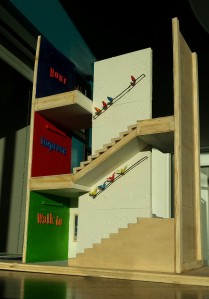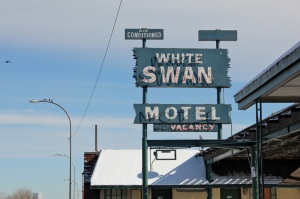Installation and sculpture artist Laura Phelps Rogers recently completed a piece titled Walk to Improve Your Outlook on the stairwell at Lamar Station Crossing apartments. The interactive piece contains a motion censor component so large neon words light up as the viewer (or stairwell walker) gets close to the installation itself. We speak to Laura about this piece and her work in general.
Tell us the premise behind the piece.
I was really interested in creating an environment. I went over to the space and spent some time contemplating how I could create a dynamic backdrop for residents. A good portion of my work is installation work, small and large scale, and I always try to run from a site-specific perspective.
What does site-specific mean to you?
It means that you go to a space and consider it as a whole, how are people using it, the location of it, the background of it, the history of it. When you think about the history of the space, what was the dominant industry? How did people fashion themselves here?
Even the color scheme for the piece was site-specific. The housing department already had a color scheme and they’d put a lot of work into developing the palette. When I interviewed them, it seemed to me that it was important to them. I enjoy doing primary colors anyway but I wanted to develop a piece that coordinated with the organization itself.
The words Walk to Improve Your Outlook work together but also have a bold meaning when they stand alone. How did the specific word choice come together?
The phrase ‘walk to improve your health’ was already there, and pretty common but it felt to me like it had been drilled into people already. The word outlook is similar but also embraces the journey toward upward mobility that Lamar Station Crossing provides. This is an apartment complex that allows people to lead a life that feels free.
What other themes encapsulate this work for you?
I think it’s about changing people’s lives through art. Art has the power to do that. That someone would want to hang out in a stairwell, that’s a pretty big accomplishment for me.
You can see Laura’s work Walk to Improve Your Outlook at Lamar Station Crossing apartments, located at 6150 W 13th Avenue, Lakewood, CO 80214.
http://www.mwhsolutions.org/lamar-station-crossing.html
See Laura’s full biography, artist statement, and work at, http://www.lauraphelpsrogers.com, or connect with her via Facebook using her full name, Laura Phelps Rogers.












